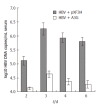Inhibition of hepatitis B virus replication by APOBEC3G in vitro and in vivo
- PMID: 16874860
- PMCID: PMC4125635
- DOI: 10.3748/wjg.v12.i28.4492
Inhibition of hepatitis B virus replication by APOBEC3G in vitro and in vivo
Abstract
Aim: To investigate the effect of APOBEC3G mediated antiviral activity against hepatitis B virus (HBV) in cell cultures and replication competent HBV vector-based mouse model.
Methods: The mammalian hepatoma cells Huh7 and HepG2 were cotransfected with various amounts of CMV-driven expression vector encoding APOBEC3G and replication competent 1.3 fold over-length HBV. Levels of HBsAg and HBeAg in the media of the transfected cells were determined by ELISA. The expression of HBcAg in transfected cells was detected by western blot. HBV DNA and RNA from intracellular core particles were examined by Northern and Southern blot analyses. To assess activity of the APOBEC3G in vivo, an HBV vector-based model was used in which APOBEC3G and the HBV vector were co-delivered via high-volume tail vein injection. Levels of HBsAg and HBV DNA in the sera of mice as well as HBV core-associated RNA in the liver of mice were determined by ELISA and quantitative PCR analysis respectively.
Results: There was a dose dependent decrease in the levels of intracellular core-associated HBV DNA and extracellular production of HBsAg and HBeAg. The levels of intracellular core-associated viral RNA also decreased, but the expression of HBcAg in transfected cells showed almost no change. Consistent with in vitro results, levels of HBsAg in the sera of mice were dramatically decreased. More than 1.5 log10 decrease in levels of serum HBV DNA and liver HBV RNA were observed in the APOBEC3G-treated groups compared with the control groups.
Conclusion: These findings indicate that APOBEC3G could suppress HBV replication and antigen expression both in vivo and in vitro, promising an advance in treatment of HBV infection.
Figures







Similar articles
-
N-terminal and C-terminal cytosine deaminase domain of APOBEC3G inhibit hepatitis B virus replication.World J Gastroenterol. 2006 Dec 14;12(46):7488-96. doi: 10.3748/wjg.v12.i46.7488. World J Gastroenterol. 2006. PMID: 17167839 Free PMC article.
-
[Inhibition of hepatitis B and duck hepatitis B virus replication by APOBEC3G].Zhonghua Gan Zang Bing Za Zhi. 2006 Oct;14(10):738-41. Zhonghua Gan Zang Bing Za Zhi. 2006. PMID: 17064466 Chinese.
-
Inhibition of hepatitis B virus replication by pokeweed antiviral protein in vitro.World J Gastroenterol. 2008 Mar 14;14(10):1592-7. doi: 10.3748/wjg.14.1592. World J Gastroenterol. 2008. PMID: 18330954 Free PMC article.
-
Hepatitis B virus DNA integration: Implications for diagnostics, therapy, and outcome.J Hepatol. 2024 Dec;81(6):1087-1099. doi: 10.1016/j.jhep.2024.06.037. Epub 2024 Jul 5. J Hepatol. 2024. PMID: 38971531 Review.
-
Inhibition of hepatitis viral replication by siRNA.Expert Opin Biol Ther. 2004 Oct;4(10):1649-59. doi: 10.1517/14712598.4.10.1649. Expert Opin Biol Ther. 2004. PMID: 15461576 Review.
Cited by
-
Susceptibility of different hepatitis B virus isolates to interferon-alpha in a mouse model based on hydrodynamic injection.PLoS One. 2014 Mar 11;9(3):e90977. doi: 10.1371/journal.pone.0090977. eCollection 2014. PLoS One. 2014. PMID: 24618716 Free PMC article.
-
Intracellular Host Restriction of Hepatitis B Virus Replication.Viruses. 2024 May 11;16(5):764. doi: 10.3390/v16050764. Viruses. 2024. PMID: 38793645 Free PMC article. Review.
-
N-terminal and C-terminal cytosine deaminase domain of APOBEC3G inhibit hepatitis B virus replication.World J Gastroenterol. 2006 Dec 14;12(46):7488-96. doi: 10.3748/wjg.v12.i46.7488. World J Gastroenterol. 2006. PMID: 17167839 Free PMC article.
-
Controllable inhibition of hepatitis B virus replication by a DR1-targeting short hairpin RNA (shRNA) expressed from a DOX-inducible lentiviral vector.Virus Genes. 2013 Jun;46(3):393-403. doi: 10.1007/s11262-013-0886-2. Epub 2013 Feb 9. Virus Genes. 2013. PMID: 23397077 Free PMC article.
-
Targeting APOBEC3A to the viral nucleoprotein complex confers antiviral activity.Retrovirology. 2007 Aug 29;4:61. doi: 10.1186/1742-4690-4-61. Retrovirology. 2007. PMID: 17727729 Free PMC article.
References
-
- Ganem D, Prince AM. Hepatitis B virus infection--natural history and clinical consequences. N Engl J Med. 2004;350:1118–1129. - PubMed
-
- Nassal M. Hepatitis B virus replication: novel roles for virus-host interactions. Intervirology. 1999;42:100–116. - PubMed
-
- Simon JH, Gaddis NC, Fouchier RA, Malim MH. Evidence for a newly discovered cellular anti-HIV-1 phenotype. Nat Med. 1998;4:1397–1400. - PubMed
-
- Sheehy AM, Gaddis NC, Choi JD, Malim MH. Isolation of a human gene that inhibits HIV-1 infection and is suppressed by the viral Vif protein. Nature. 2002;418:646–650. - PubMed
Publication types
MeSH terms
Substances
LinkOut - more resources
Full Text Sources
Other Literature Sources

